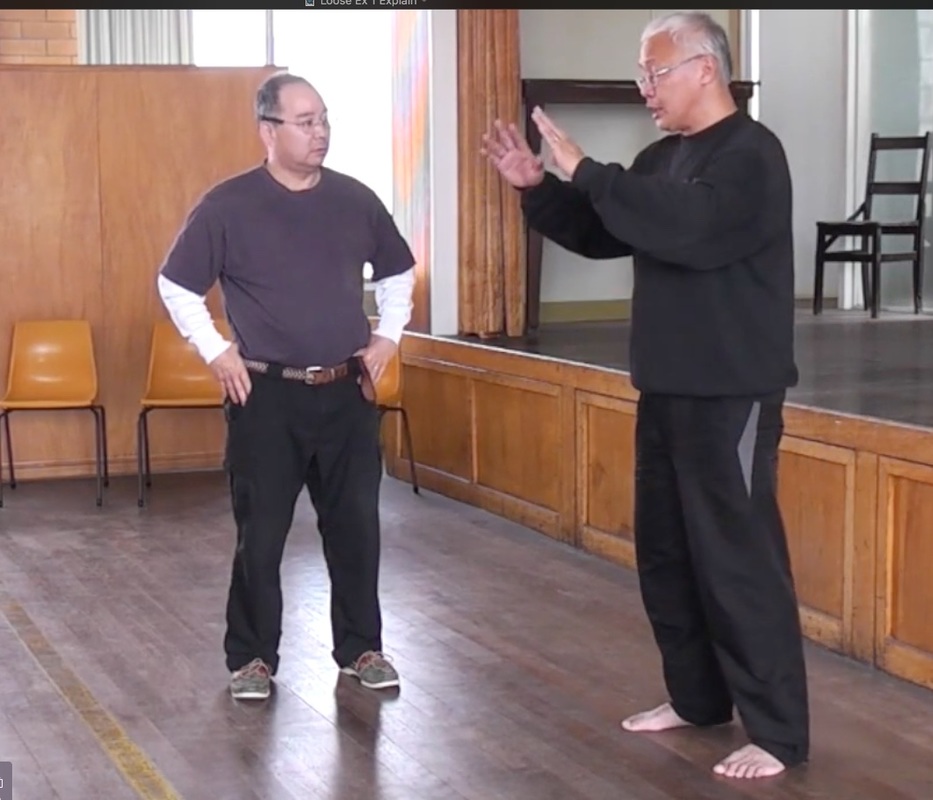Just focussing on your arms and hands (let alone your base) - what do you do with them? Where are they? Why am I trapped? - feels like an impossibility. When your mind goes blank all those classical Taiji movements seem so impractical and forgotten.
So you make a few attempts to yield and execute relaxed movements like the "push", or "ward off" or "da lu" trying to keep relaxed and not use force but in a blink of an eye you're wrestling with your opponent in a battle to control the middle-centre ground between both of you. It becomes a shoving, wresting match where whoever hunkers down and controls that centre space wins. Your pushes become forceful shoving and you use your legs and body as "leverage" anchoring it to the ground. To be pushed over is akin to death and you desperately fight for your life using whatever tricks and strength you have at your disposal. And just as you resort to such "force" so does your opponent - hence the cycle is reinforced. Is this true Taiji? In that moment often you're not even aware that it is your shaken "ego" that is dictating your response. The fear of losing or being dominated, or being exposed for not being good at your Art, are the main motivators of your actions. After all the time, physical, social, intellectual and emotional investment you've put into your Taiji why can't you get it to work?
When I read books written by practitioners with impeccable skills and knowledge and asked similarly qualified teachers these questions, the answer is always the same - "carefully study the movements in the Taiji form". This seems so unsatisfying an answer because the movements, transitions and postures often appear to have nothing to do with any martial application, or often appear indirect and "flowery". And even when they appear obvious, you need a willing and good training partner to experiment, and regularly practice with in a give and take situation (finding such partners also is a task in itself - but not impossible and requires some patience). Let alone applying these pair work techniques in a fluid situation under the constant pressure of being pushed at first seems way too big a hurdle to bridge. But as we patiently accurately train, progress, look, and study sincerely, these mountains seem to disappear. And what seemed so impossible at the time now are achievable and we can focus on further improvement ahead.
What I've discovered is that the more you understand, execute and integrate the "pieces of the puzzle" which involve the mastering the very "basics" - the more you begin to be able to apply the techniques in a free push situation. Which means - the more you stick to (and patiently invest the right amount of time in) the order of the traditional training stages (which are cleverly and logically sequenced) the more you're able to build on the solid foundations for using your real Taiji within the free and spontaneous give and take of the free push. Then the movements in the form and fixed pair work begin to reveal themselves to you in the free push.
When you do get to stage of testing yourself in a free push situation, you still have to bridge the large gap between moving and responding fluently in fixed pair work exercises to the unexpected, changing challenges in a free push situation. It is impossible for the teacher to train you with the appropriate technique to handle every possible scenario and therefore you have to be more independent and do lots of work to reflect on the movements, principles, and mindset you have been practicing in your Taiji up till then. I've also found that watching videos of how my teacher and other more experienced practitioners respond to, and apply push hands techniques in such a free and unrehearsed situation on YouTube to be the best source for me when I don't have regular access to someone better to push with. For me, reading about how to apply techniques is so confusing or vague that I don't bother.
Authour - Lee Chang Tye
www.relaxedmindtaichi.com

 RSS Feed
RSS Feed